Our sailing season finally got underway on July 15th. The latest start we’ve ever had. A month later than we had planned as we had arrived in Nova Scotia in early May figuring we’d be in the water and ready to go by June 15th. Anyone who has messed around with boats knows that if you think a task will take an hour, it will take three for good measure!


But we completed some major boat projects like repairing a leaking water tank, touchups on all the exterior brightwork (wood trim), installation of a loud hailer on the mast, and a new VHF radio that is connected to the loudhailer. The latter was installed in anticipation of frequent fog.
Hiccup 1
There are always a few issues that throw a monkey’s wrench into the works. After the mast was raised on Gaviidae, we discovered that one halyard (line that hauls the sail to the top of the mast), was stuck. We couldn’t pull it up or down. Inspecting the problem required me going up to the top of the mast to determine where it was jammed. Through process of elimination, we figured it was stuck inside the mast about ¾ of the way up. Stuck on what was the next question.
After much head-scratching and consulting with Mike Gozzard, he suggested trying to force it using the winch. He said we might damage the halyard, but it was really the only option. While I was still sitting in the bosun’s chair halfway up the mast, Dan put the stuck halyard on a winch and cranked away. There was a huge bang from within the mast above my head. The halyard was free with no apparent damage!
Hiccup 2
Our first attempt at launching Gaviidae failed when we discovered water leaking in from the thru hull that was installed to replace a compromised thru hull valve. This particular thru hull was below the water line. Leaking was not a minor annoyance, it was boat-threatening (the boat could sink!)
After this very brief little swim, Gaviidae was lifted back out of the water and plopped back on the jackstands. The crew at Shining Waters Marina removed the thru hull, re-installed it with a lot more sealing “goop”.
Gaviidae’s second swimming lesson was a few days later after the goop had time to set. This time there were no traces of water seeping through. Gaviidae was free to swim without the water wings!
Test Run
Mark and Jeanne, our friends from Minnesota, had planned on meeting us in the Bras D’Or Lakes on Cape Breton, NS. Since we were still in St. Margaret’s Bay, they joined us there and we spent a few days sailing in the area and testing out the boat systems.
After anchoring out for a couple of nights, we sailed over to Hubbard’s Point and the home of the Tuna Blue inn and restaurant. Happy Hour at Tuna Blue started at 1500 and we arrived at 1430 – just enough time to freshen up before joining the festivities. Their end dock was just big enough for Gaviidae, so we were able to stay overnight and enjoy a lovely dinner in the restaurant.
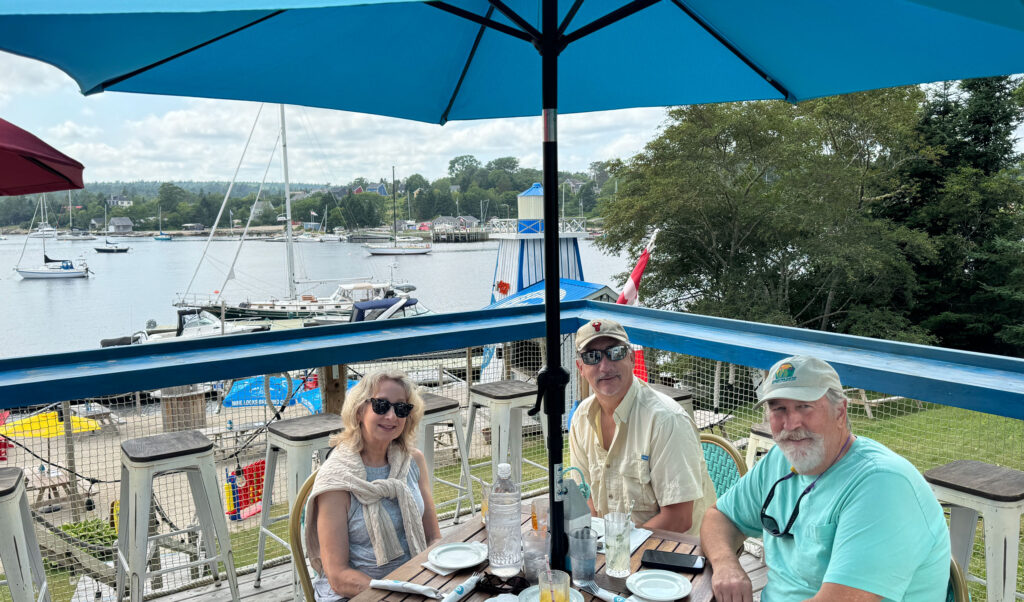
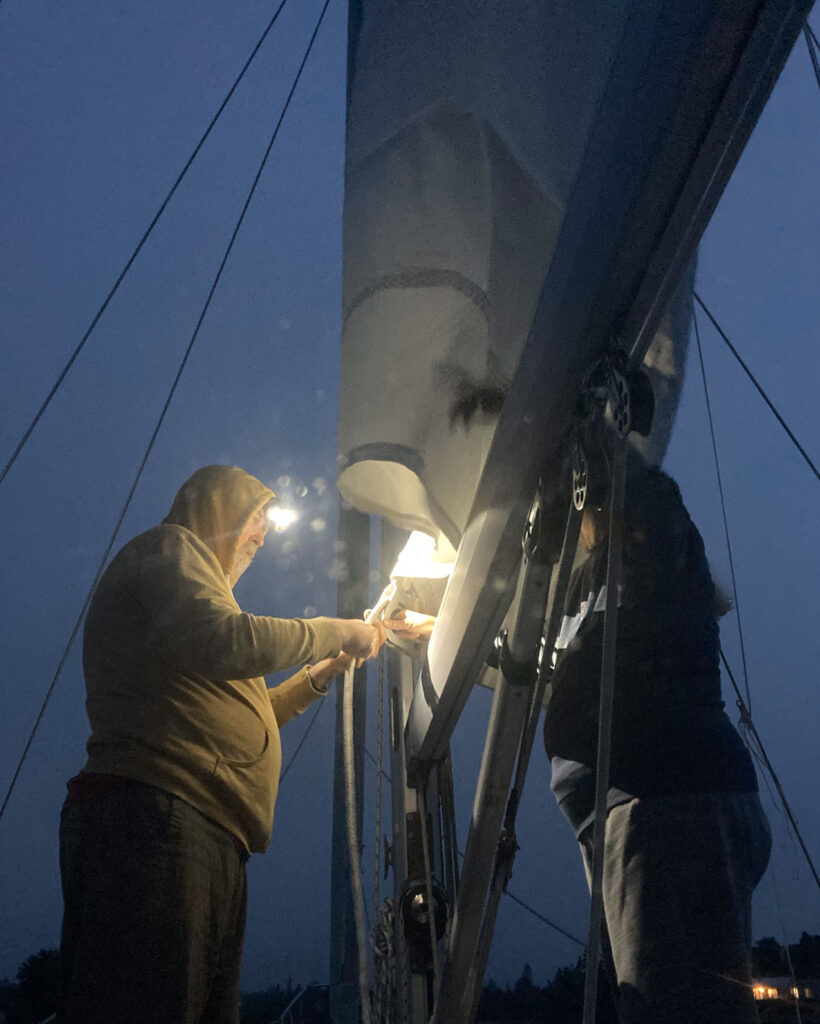
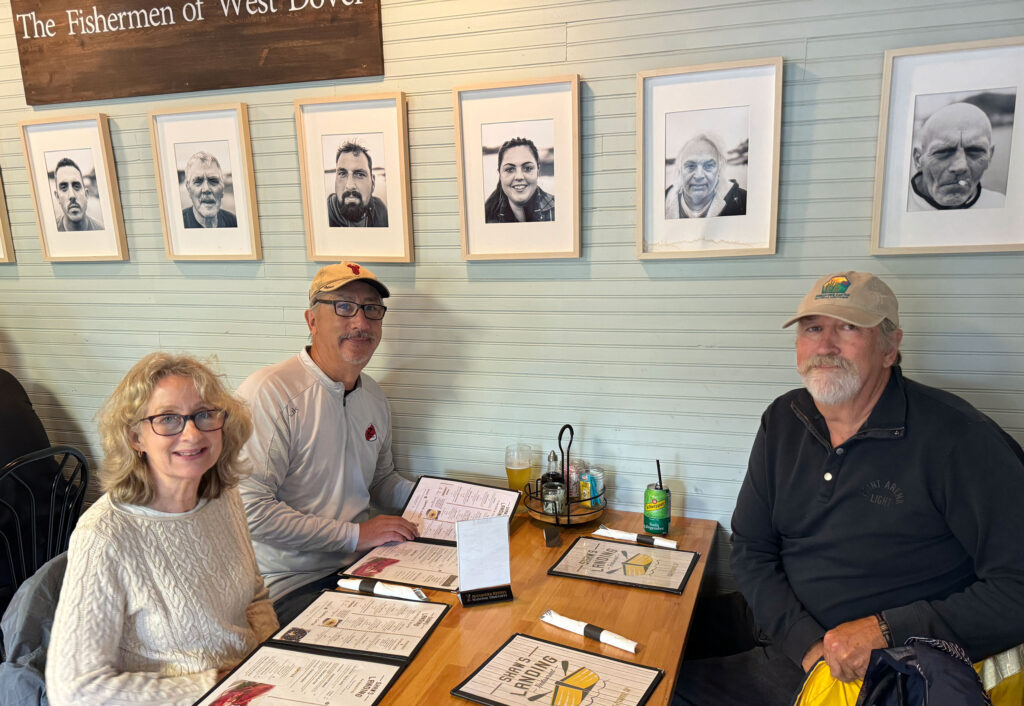
We returned to Shining Waters and said farewell to M&J, who headed off to see the big tide changes on the Bay of Fundy.
Fog bound
After emptying the refrigerator in the RV and buying a few more provisions for the boat, we left Shining Waters on July 21st, a beautiful, sunny day. Our destination was Rogue’s Roost, an anchorage that was listed as a favorite in the cruising guide we were using.
The favorable winds dropped shortly after our departure forcing us to use the engine. The drop in winds also brought in thick fog. We quickly turned on the radar and our running lights. At times it was hard to see the bow of the boat!
We cautiously puttered along at around 4 knots as our radar geared up when I suddenly spotted a couple of small scows right in front of us! Apparently, we had sailed into a regatta – in the fog! When radar finally came onscreen we could see the sailing committee boat and several sailing scows huddled close to it, but a few of the scows were practicing while waiting for the fog to lift. It was these scoundrels that were now in front of Gaviidae. With a hard turn to starboard, we avoided careening into a couple of them only to find a few more still in our path. They scrambled, we scrambled, and we avoided disaster.
Then I remembered that we had a newly installed foghorn…oops. With the foghorn periodically announcing our presence, we continued at a slow pace to the mouth of St. Margaret’s Bay relying on our Raymarine chartplotter and radar for guidance and safety. We were in heavy fog to the mouth of the bay, the intermittent fog beyond and past Peggy’s Cove—some 8 nm and a couple hours later.
Rogues Roost
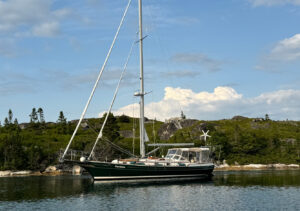
The cruising guide did not mislead. Rogues Roost turned out to be a lovely anchorage, with several anchoring options. The intimidating entrance was simplified at low tide – all of the hidden rocks were exposed making it very easy to navigate!
The Roost consists of one large bay that could hold many boats or a much smaller bay that could hold maybe 2-3 boats. We opted for the latter and found one large sailboat anchored there. Plenty of room for us. After dinner, we took the dinghy out for a ride and explored the larger anchorage for future reference. Equally lovely!
Next Hop
We had planned to do about a 30NM hop the next day to Sambro which is just before the entrance to the Halifax bay area. We were underway before 0800 and headed out into light breezes and clear skies. We headed offshore, trying to find waters that had less roll and ended up about 8NM offshore.
The distance was important because we had to cross into international waters sometime before July 31st, as required by our Canadian customs permit. We opted to keep sailing further out since we were already so close. Once we hit the 12NM mark, I called customs and after a two-minute conversation, had all the official paperwork completed and approval to continue.
Stopping at Sambro was no longer an option as we were now east of Halifax. We adjusted our course, so the waves were directly behind us and headed towards land.
What the heck is that?
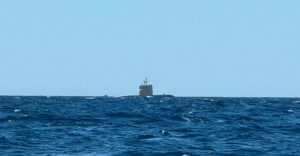
While Dan was taking a siesta, I was on watch. I saw a large structure in the distance. At first I thought it might be a power plant on shore. But then it started to move. Or did it? My eyes were playing tricks on me – buildings don’t move. And nothing was showing on AIS (Automatic Identification System), a boat monitoring system that tracks nearby vessels broadcasting on AIS.
As we continued, our path with this weird building started converging. It was indeed moving. When it was close enough to see clearly with the binoculars, I realized it was a large submarine cruising unescorted along the surface! WTH!
Southwest Cove and Deep Cove
We ended our second day after 65 nautical miles and dropped anchor around the bend from Owls Head in Sheltered Cove. We shared an anchorage with a large sailboat out of New York named Salty Ginger. The wave direction changed overnight, and we had rolling waves coming in on our side. Dan slept like a baby in a cradle. Me, not so much.
After the long day prior, we wanted a short hop to recoup and avoid the big waves that were predicted along with another wind-direction change. We did a short 5 nm hop to Deep Cove off of Borgles Island. The chart showed a shallow area deep into the cove where it was supposed to be 6 feet or less. We circled around it and through it and found nothing less that 14 feet. Even with the tide change of six feet, we had plenty of water beneath us.
Aside from some kayakers that passed through, a few seals, and a very noisy Osprey, we had the bay to ourselves.
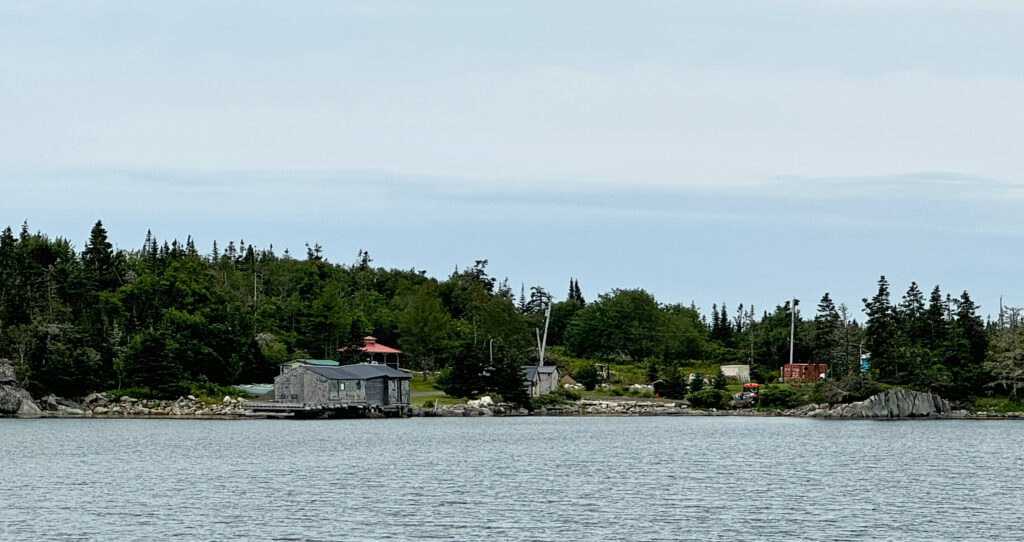
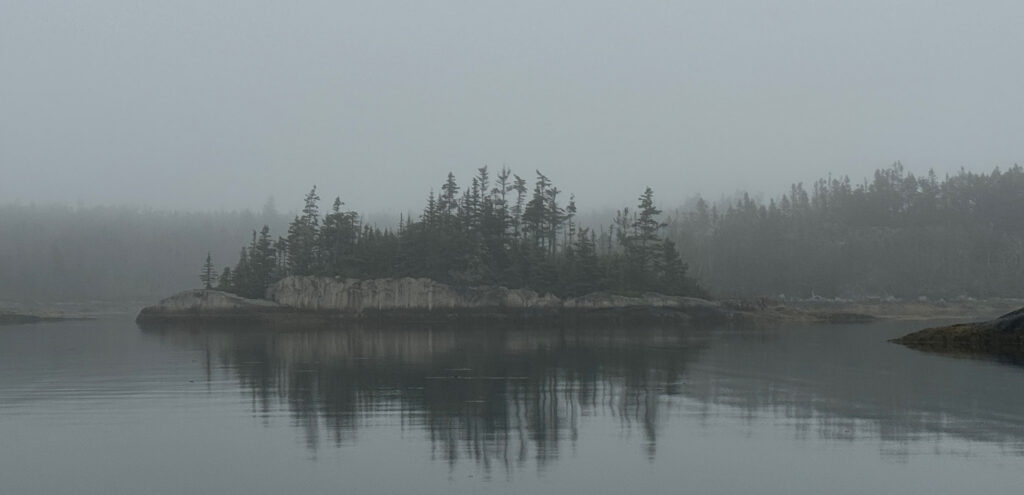
Shelter Cove and Taylors Head
One of the anchorages we stopped at last year was Shelter Cove. A lovely spot and I wanted to park there for a couple of days and hike the beach and perhaps enjoy a glass of wine on the bow. We departed Deep Cove early to avoid the predicted fog and wiggled our way through the Inner Baltee Passage as outlined in the cruising guide.
There are a number of these inside passages along the Eastern Shore of Nova Scotia. With some passages, the cruising guide warns of shoals, rocks, and the need for a bow watch. For sailors who have wiggled into some white-knuckle anchorages on Lake Superior or Georgian Bay, these were a cake walk! But we did heed their advice and Dan stood watch on the bow enjoying the fresh air.
Along the way we passed a seal sunning on a rock just big enough for the seal. Counting sea creatures keeps me entertained – seal count: 9 seals including 1 pup.
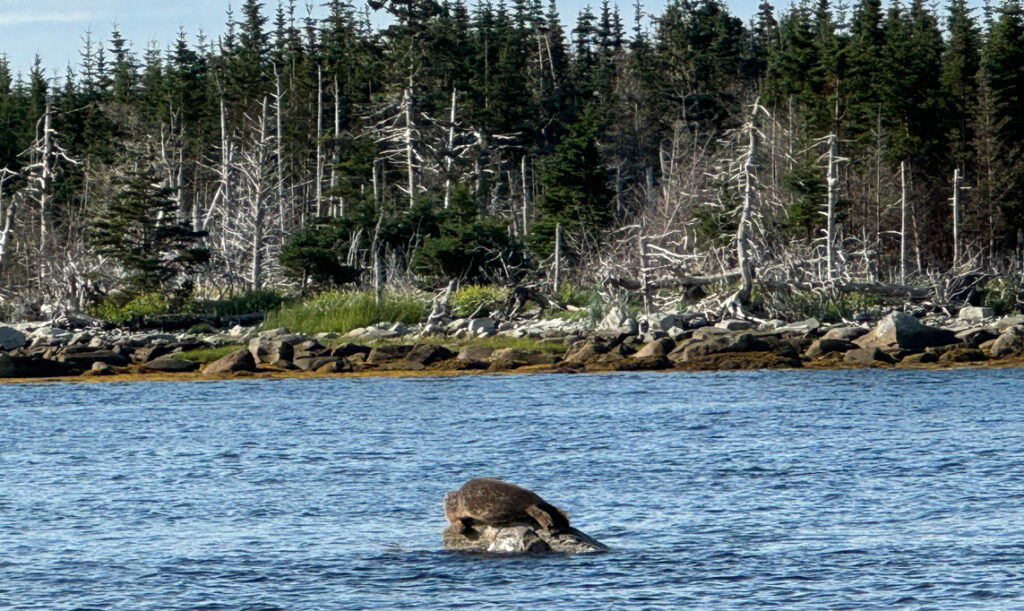
We arrived at Shelter Cove before 1000 and enjoyed a little brunch. After consulting the weather again, we opted to continue on to Taylors Head. There is no inside passage to Taylors Head – you have to go outside and around Taylors Head point. The winds had been light which we translated to meaning the waves outside would be reasonable and the fog never materialized.
There is a provincial park on Taylors Head and a large bay with a white sand beach. The slope to the shore is gradual allowing you to get quite close when dropping anchor. As the sun departed, so did the beach goers. We shared the large bay with a loon.
Jammed Mainsail
We left Taylors Head the next day at 1030, after a leisurely morning. Our destination was Orkney, less than 30 nautical miles away. It looked like a good sailing day with winds from the southeast, so we headed to the outside.
It should’ve been a good sailing day but we discovered our mast-furling mainsail was jammed in the mast. Our sailing consisted of the staysail and the engine. By 1500, the winds had died to 3 knots and even the staysail was of no use.
Once anchored in Orkney, we were able to get the mainsail out and rolled back in smoothly.
Harbour Island, Again
We anchored at Harbour Island on our way to Halifax last fall. At the time, we shared the anchorage with numerous seals. This time there was no sign of seals, just a huge flock of cormorants on the spit. We dropped anchor facing the southwest wind and proceeded with dinner prep.
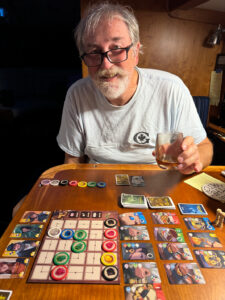
About an hour later, the wind direction changed to northwest and was gusting up to 20 knots. The weather report gave no indication of a wind direction change or an increase. We discussed re-anchoring or moving completely but decided that our trusty Mantus would hold us tight. It did.
Grande Greve – Cape Breton
The wind change overnight had flattened the sea state and we headed outside into the Atlantic. I had flagged numerous stopping points, all depending upon the wind. The weather reports had indicated that a strong north wind was to be expected.
Mother Nature did not see the memo from the Canadian weather service. We had winds from the southwest, south, northwest, and finally west later in the day. With calm seas, we continued on. As we passed Isle Madame, we sailed through a large pod of dolphins – such a treat! We dropped anchor in Grande Greve, just outside the canal entrance to the Bras D’Or Lakes. We did 56 nm on a 9-hour day.
Happy Reunion
We had been monitoring the other Gaviidae on AIS as it left Price Edward Island and came through the Canso Lock. They had come down the St. Lawence Seaway over the last couple months. They were closing the distance gap between us and we saw they had dropped anchor behind an island about 20 nautical miles away.
As we were puttering around the next morning, I happened to see a text message from Howard and Kerri-Ann demanding that we get out of bed because they were off our stern!
Gaviidae rafted alongside, and we enjoyed a reunion brunch before both boats headed to the St. Peters Lock a couple miles away and the St. Peters Marina just beyond the adjacent ancient rotating bridge.
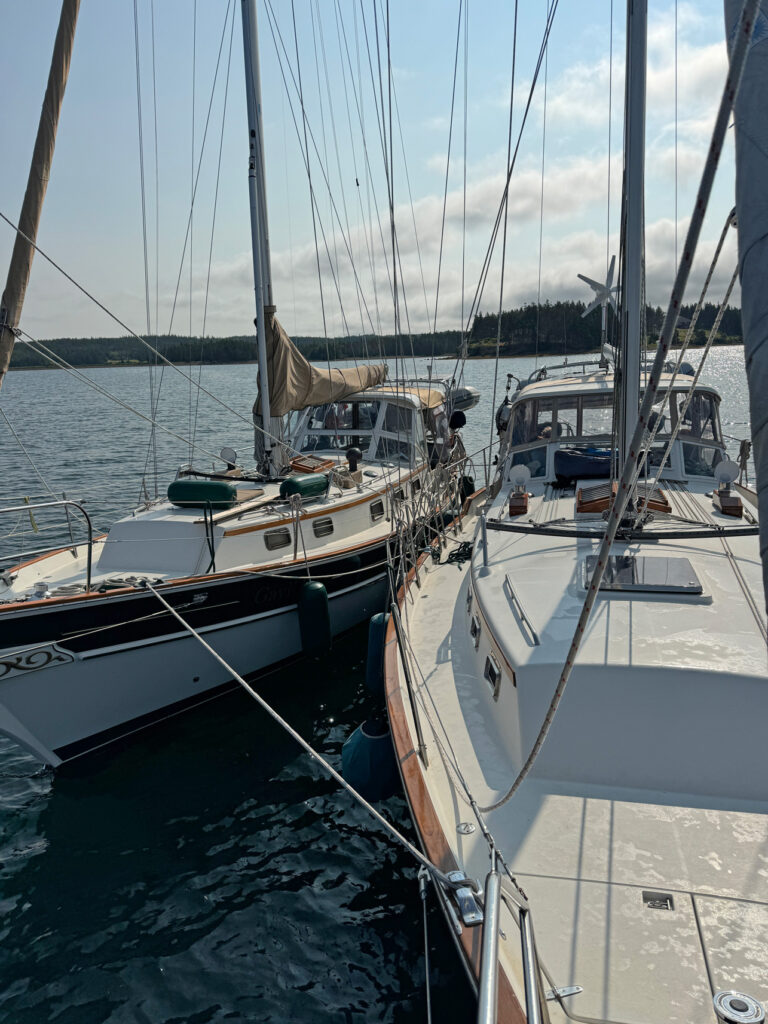
Grande Greve Harbour
July 15-July 28, 2024 247 Nautical Miles 45°37.911’N 060°51.853’W
For exact locations (latitude and longitude) for each stop, please visit our Map Page or our MapShare.

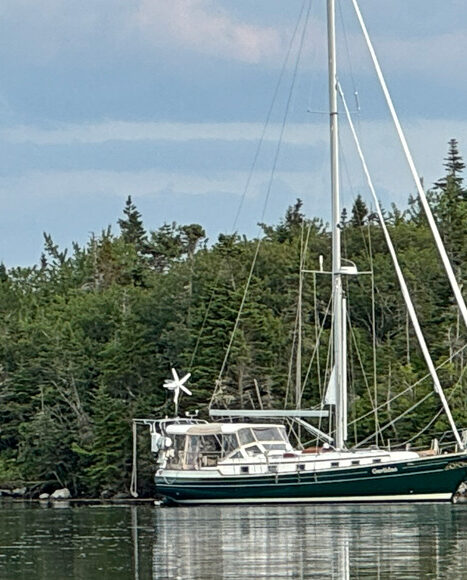
Surely the submarine had AIS. Operating in stealth mode?
Nope – and we’ve learned that military vessels rarely broadcast AIS.
Dan and Julie,
I have been trying to connect with you to see if you would be willing to start an email conversation with me. I am the son of the prior owner of your boat (then Frances). My wife and I are planning on shipping our boat to Duluth and sailing back to Rhode Island. I am hoping to tap into your knowledge of the are to facilitate. Let me know if you can be available for advice.
Thanks!
Matthew Smith
Hi Matthew,
Have had very limited internet for the past month. I sent you an email – did you get it? Happy to share what we know.
Julie
Awesome!! I love reading these. Sorry you had so much “stuff” to deal with, but hey–that’s sailing! What does the rest of your float plan look like for the remainder of the year?
Hi Kevin,
We will be leaving the Bras D’Or within a week – starting to watch for a weather window. Then we will head down the coast of Nova Scotia with stops in Halifax, St. Margaret’s Bay, Mahone Bay, etc. Expect to cross to Grand Manan and then into Maine before the end of August. Then south of Annapolis before the end of September. Let us know if/when you want to join us!